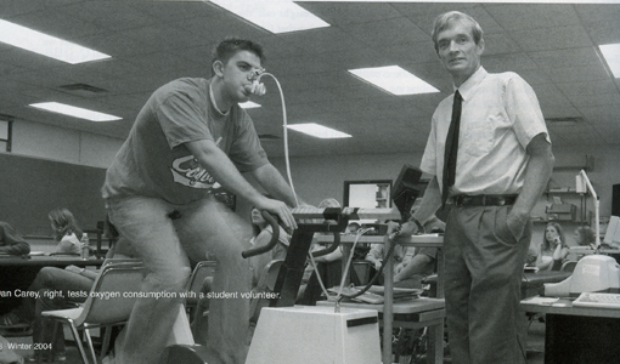Interestingly enough,of the 150 faculty and staff members who showed up last year for a special personal training program, only a few were men. “I’d have to be a psychologist to speculate accurately on why this happens,” said Dr. Dan Carey, “but basically I think women seem more concerned about health. Some men have that ‘I’d rather not know’ attitude.”
Carey, who works with students and employees at St. Thomas and with competitive athletes from the region, would like to change that. He teaches, promotes and measures good health and has taught in the Health and Human Performance Department at St. Thomas since 1988.
In addition to classes in physiology, health education, exercise for special populations (those with chronic diseases such as arthritis or diabetes), he also directs the programs for about 50 majors in the Health Promotion area. From there, students may work in corporate fitness sites, state agencies or public schools. Many go on for an advanced degree in physical therapy. “With health care costs going through the roof, preventative and secondary health appraisals can be valuable in many areas,” Carey said.
Students can be personal trainers
The “Healthy U” program at St. Thomas, dedicated to the advancement of health for the faculty and staff of the university, is another area of interest. Through testing and evaluation programs, ongoing classes from yoga to smoking cessation to the 10,000 steps (a day) program, to brown bag lectures on fad diets and stress management, Carey works with Human Resources and the Wellness Center at the university. His senior students serve internships as personal trainers for the approximately 1,200 faculty and staff at St. Thomas.
“Students love doing that,” he said, “because many of them are so good working with people. Our classes are not ‘dumb jock’ courses that often have been associated with this field; they are science courses, and include biology, chemistry, physics and calculus. There is a science to what we do, and we also enjoy improving lives.”
The science is evident in the physiological testing Carey does for competitive athletes, including maximal oxygen consumption, anaerobic power and underwater weighing for body fat percentage. He has conducted national research on the Breathe Right Nasal Dilator and on the Nordic Track Ski Ergometers.
“It’s all fascinating,” Carey said. “In the maximal oxygen test, we collect expired air to estimate calories burned and aerobic efficiency. In the underwater weighing, subjects wearing a swimsuit and sitting in a chair in the water – equipment that a University of Minnesota engineering class built for Carey – are asked to put their heads underwater and breathe out for three seconds.
Most tests are free or have a minimal charge and Carey puts all revenue into improving equipment in the Health and Human Performance Lab that he oversees. “Our facilities at St. Thomas are tremendous, and many classes from other A.C.T.C. schools come to St. Thomas to see demonstrations on equipment that they unfortunately do not have in their institutions. “I’ve got a wonderful job.”
A competitive cyclist (he does about 35 miles a day), once a marathoner, the 6-foot-2-inch, 175-pound Carey had been a professional minor league baseball pitcher for the New York Mets. And he was, at 230 pounds, overweight. “You call yourself a pro athlete, but you sure don’t look like one,” his dad said, so Carey started running and became interested in fitness.
Diabetes is rampant
“After discovering that I was not going to make about $20 million a year for pitching a ball,” he studied at the University of Minnesota and worked as an exercise physiologist with cardiac patients. He received his doctorate in kinesiology in l996 and moved into preventive health.
“With diseases like diabetes now rampant in our society, weight control is vital, so I exercise. That’s boring in the winter, doing 35 miles on a bike indoors, but I compare it to beating your head against a wall; it feels so good when you quit.”
People need to combine sensible weight control and exercise. “It can be as easy as walking for 10 minutes after work,” he explained. “Then after a couple of weeks, do 10 or 15 minutes more. People need 30 minutes of consistent moderate activity on most if not all days of the week. It’s pretty simple.”
Sensible exercise is good
“Sensible” is what Carey stresses, noting that not everyone has the same body type.Men and women react differently to the current craze to watch weight excessively. “We eat fewer calories than we did in the early 1900s but we did hard, physical labor every day then, too. Weight control is one important key to good physical health, but unfortunately some young men try to achieve that by overexcising for hours a day and some young women develop eating disorders. Our students are uniquely educated in health concerns and benefits in classes like Physical Education 100, required of all St. Thomas students, which emphasizes personal health and wellness through sensible diet, emotional health, and exercise. But sometimes that high priority on looking good becomes unhealthy.”
“I’m not a fanatic,” Carey laughs, but is willing to repeat the well-known story of how he used to drive to work. “I lived a few miles away from St. Thomas and to keep my windshield from fogging up inside on those really cold winter days, instead of waiting for the defroster to warm up, I would just drive and hold my breath in as long as I could. I got so I could do it for better than a minute – not bad exercise.
